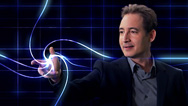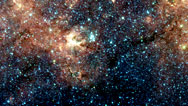The Making of the Quantum Club
- By Anna Rothschild
- Posted 10.27.11
- NOVA
It took hundreds of hours to shoot and animate a scene in the so-called Quantum Club, from "The Fabric of the Cosmos" with Brian Greene. NOVA's Julia Cort, one of the producers of the show, explains how she and her colleagues created the scene to make the quantum world come alive.
Transcript
The Making of the Quantum Club
Posted: October 27, 2011
JULIA CORT: The Quantum Club was one of the more complex animated scenes in "The Fabric of the Cosmos." It introduces the audience to the strange world of quantum mechanics, which governs how matter behaves at the smallest of scales.
When you get down to the size of a subatomic particle, everything is counterintuitive. For example, a particle might seem to be in multiple places at once. It's a confusing topic, so we wanted to use the club as a metaphor for this bizarre idea—creating an environment where people and objects act like atoms and particles, popping in and out of the shot.
We started off with a rough script and storyboard. An artist created hand-drawn still images and some very simple animation for the scene, and we then added some scratch narration and effects to give ourselves a sense of what the scene might look like.
Next, we worked with an animator to build some 3-D renderings called animatics. We knew that filming was going to be very complicated, so we used the animatics to help design each shot—making sure the shots flowed properly and figuring out which camera angles to use. In this shot, the blue guy is supposed to be Brian Greene.
The next step was to film the actual scene. We wanted to give the club an otherworldly feel, so we shot against a green screen, which makes it easy for editors and animators to come in later, digitally remove all the green from the image, and replace it with something else.
One of the challenges while filming was that, to make it look like people and objects were multiplying or disappearing, we needed to shoot many versions of each shot, and layer them on top of one another. The tricky thing was that the real objects—like the bar or the pool table—needed to be in the same position each time, so it would look like only people or certain objects were popping from one location to another. To create this effect, we used a camera with a special computer-controlled dolly that could repeat the same motion at the same speed over and over again.
Finally, we layered all the different versions of each shot, replaced the background walls with virtual ones, and added some additional special effects. It took around 300 to 400 hours of animation work. And that was all after we finished filming.
Our goal while making the Quantum Club was to explain what is both inherently weird, and exciting, about the quantum world. I hope you like it.
BRIAN GREENE: But what if you could visit a place like this, where the quantum laws were obvious, where people and objects behave like tiny atoms and particles?
You'd be in for quite a show.
Here, objects do things that seem crazy.
I mean, in the quantum world, there's a sense in which things don't like to be tied down to just one location or to follow just one path.
It's almost as if things were in more than one place at a time.
And what I do here can have an immediate effect somewhere else. Even if there's no one there.
And here's one of the strangest things of all. If people behaved like the particles inside the atom, then most of the time, you wouldn't know exactly where they were. Instead, they could be almost anywhere until you looked for them.
Hey. I'm gonna have what he's having.
So, why do we believe these bizarre laws? Well, for over 75 years we've been using them to make predictions for how atoms and particles should behave. And in experiment after experiment, the quantum laws have always been right.
ALLAN ADAMS (MIT): It's the best theory we have.
SETH LLOYD (MIT): There are literally billions of pieces of confirming evidence for quantum mechanics.
WALTER LEWIN (MIT): It has passed so many tests of so many bizarre predictions.
ADAMS: There's no disagreement between quantum mechanics and any experiment that's ever been done.
GREENE: The quantum laws become most obvious when you get down to tiny scales—like atoms—but consider this: I'm made of atoms. So are you. So is everything else we see in the world around us. So it must be the case that these weird quantum laws are not just telling us about small things, they're telling us about reality.
Credits
PRODUCTION CREDITS
- Original Footage
- © WGBH Educational Foundation 2011
- (main image: Brian Greene in the Quantum Club)
- © WGBH Educational Foundation 2011
Special thanks to Rebecca Nieto
Related Links
-

The Fabric of the Cosmos
Acclaimed physicist Brian Greene reveals a mind-boggling reality beneath the surface of our everyday world.
-

Spooky Action at a Distance
That's what Einstein called it, dismissively, but ultra-strange quantum entanglement does exist, Brian Greene writes.
-

A Quantum Leap in Computing
MIT's Seth Lloyd, a pioneer of quantum computing, explains its applications and revolutionary potential.
-

A Trip Through Spacetime
Join Albert Einstein on a high-speed cab ride to see why space and time are truly in the eye of the beholder.

